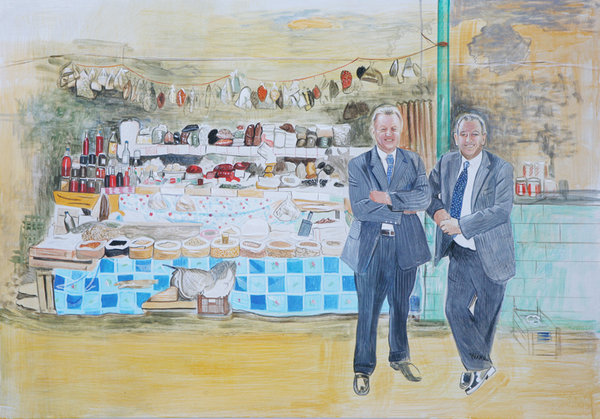Johanna Kandl
dal 16/3/2009 al 24/4/2009
Segnalato da
16/3/2009
Johanna Kandl
Christine Konig Galerie, Wien
The Missing Guardian. Kandl's images draw their vexing effect and also at times their strange humor from the rift between the suggestive forces of global capitalism and a pathetic life reality. Some works address the artist's own past, depicting the facade of her parents' paint shop on Brunnerstrasse.

Johanna Kandl's images draw their vexing effect and also at times their strange
humor from the rift between the suggestive forces of global capitalism and a
pathetic life reality. "I enjoy the fact that there is a rift between image and
text." The painting The Missing Guardian after which the exhibition is named shows
two men, both wearing business suits and in a very good mood, standing in front of a
sales stand. Investors? Social descendants? New moderation?
Other works address the artist's own past, depicting the façade of her parents'
paint shop on Brünnerstrasse with signs advertising brands no longer existing today.
The marginal small businesses make frequent appearances in her compositions with
only the geographical coordinates changing: Viktor Adler market in Vienna, Belgrade,
Baku, Ukraine, Bosnia, Karl-Marx Allee in Berlin. It is this world undergoing
transformation that Johanna Kandl has captured in small sections of reality.
Her works are anything but abstract which also holds true for the process of their
production. The artist usually begins with photographs that she or her husband
Helmut Kandl has made. The global archives of imagery, whether supplied from the
Internet of from journals, are of no interest to her. Art is an avowal to the
particular, to narrative fragments that cannot be arranged to form a large narration
but rather stick in a state of the chthonic.
The present-day economic crisis is playing into the hands of Johanna Kandl's modules
of world interpretation in the sense that it retroactively adds a negative energy to
the text-image combinations. Now it is not about a disproportionate relation between
a super-capitalism that is triumphantly gesturing with its slogans and rhetorical
expressions of pathos and its less capital-intensive marginal locations but about a
universal dystopia.
Capitalism is the first case of a blaming rather than repenting cult, as Walter
Benjamin wrote in 1927 in a text that is still worth reading today: "The nature of
the religious movement which is capitalism entails endurance right to the end, to
the point where the universe has been taken over by that despair which is actually
its secret hope. Capitalism is entirely without precedent, in that it is a religion
which offers not the reform of existence but its complete destruction." (cited after
Walter Benjamin)
A large-format painting, very thin, almost painted in the grisaille style, depicts a
huge number of sacral figures at a stand in Medujgorje. Next to it there is a piece
on "Pyramid Games" and the "Pyramid" of Visoko in Bosnia where small tourism has
been developing in recent years. A Bosnian living in exile disseminated the theory
that the city hill was a pyramid - the oldest and largest in the world.
One video shows the Piazza in Loreto, a Madonaro (street painter), Maltese nuns, a
colorful Fiat sports car being blessed, a swarm of bees which on Pentecost Sunday
punctually landed on a fountain figure and transformed it into a swarming, amorphous
mass.
For the video "Brünnerstraße 165" in 2008 Johanna stepped again into the garden pond
behind her family's shop. You see the family being filmed by her father with an 8 mm
camera.
Johanna Kandl's reports on the periphery of the world and on the end of an epoch are
attempts to translate the world in which we live - whose visual substrates spin
about us as serial images from the media - into a state of lasting imagery,
epigrammatically. Painting has more plasticity than photography - and at the same
time it should be recognizable in terms of its illusionistic character. It is a
subtle tight rope walk which when successful is able to establish an ontology of
instability. “Sometimes history catches up with you,” as Johanna Kandl says. “Maybe
my work assumes more clarity as a result of the crisis. It's different in any case.”
Selected Exhibitions:
2009 Snipers on the Market, Galerie Kisterem, Budapest (S); 2008 Bild fliegt,
Galerie Patrick Ebensperger, Graz (S); Experimenta Folklore, Kunstverein Frankfurt
(G); 2007 Volksgarten, Kunsthaus Graz (G); Geographie is Dead, Dortmunder
Kunstverein (S); The Painting of Modern Life, Hayward Gallery, London (G); 2006
Kämpfer, Träumer & Co., Lentos Kunstmuseum Linz (S); Academie, Muhka, Antwerp (G);
2005 I Sell Paintings What Do You Sell?, Christine König Galerie, Vienna, (S); 2004
You never know what will happen next, Galerie Six Friedrich Lisa Ungar, Munich;
speaking in public, Art 35 Basel; 2003 speaking in public, 9. Cairo Biennale;
Kämpfer für's Glück, Kunstverein Ulm; 2002 Kämpfer für's Glück, Christine König
Galerie, Vienna (S); Painting on the Move, Kunsthalle Basel (G); Galerie für
Zeitgenössische Kunst, Leipzig (S); ungemalt, Sammlung Essl, Klosterneuburg (G);
2001 don't worry, be happy, Fotohof Salzburg (S); Your way to the top, project in
cooperation with museum in progress, Vienna (S); 2000 DerDieDas FREMDE, Christine
König Galerie, Vienna (with Olga Chernysheva, Kara Walker); 1999 Secession, Vienna
(S) G group exhibtion; S solo exhibition
Thomas Mießgang, Vienna 2009
Opening: March 17th, 2009, 7 - 9 p.m., together with the galleries Gabriele Senn,
Georg Kargl and Engholm Engelhorn.
The artist will be present.
Christine Konig Galerie
Schleifmuhlgasse 1A - Vienna
Free admission



